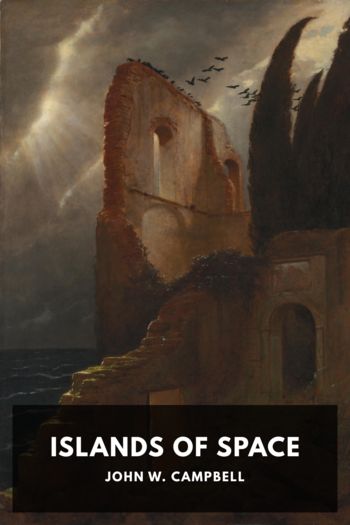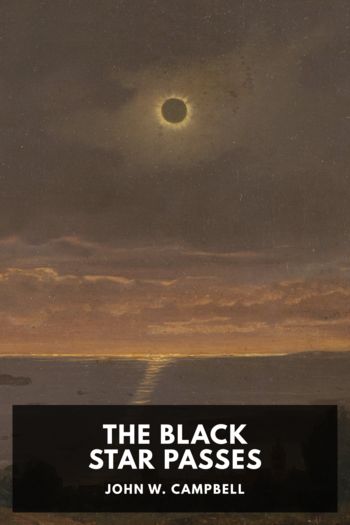Islands of Space - John W. Campbell (pdf to ebook reader TXT) 📗

- Author: John W. Campbell
Book online «Islands of Space - John W. Campbell (pdf to ebook reader TXT) 📗». Author John W. Campbell
The ship was in as perfect condition as it had ever been, for every bearing had been put in condition and the generators and gyroscopes were running smoothly.
They threw the ship into full speed and headed for the galaxy ahead of them.
“We are going to look for intelligent beings,” Arcot reminded the others, “so we’ll have to communicate with them. I suggest we all practice the telepathic processes I showed you—we’ll need them.”
The time passed rapidly with something to do. They spent a considerable part of it reading the books on telepathy that Arcot had brought, and on practicing it with each other.
By the end of the second day of the trip, Morey and Fuller, who had peculiarly adaptable minds, were able to converse readily and rapidly, Fuller doing the projecting and Morey the receiving. Wade had divided his time about equally between projecting and reading, with the result that he could do neither well.
Early on the fourth day, they entered the universe toward which they were heading. They had stopped at about half a million light years and decided that a large local cluster of very brilliant suns promised the best results, since the stars were closer together there, and there were many of the yellow G-0 type for which they were seeking.
They had penetrated into the galaxy as far as was safe, using half speed; then, at lower speeds, they worked toward the local cluster.
Arcot cut the drive several light years from the nearest sun. “Well, we’re where we wanted to be; now what do we do? Morey, pick us out a G-0 star. We await your royal command to move.”
After a few minutes at the telectroscope, Morey pointed to one of the pinpoints of light that gleamed brightly in the sky. “That one looks like our best bet. It’s a G-0 a little brighter than Sol.”
Morey swung the ship about, pointing the axis of the ship in the same direction as its line of flight. The observatory had been leading, but now the ship was turned to its normal position.
They shot forward, using the space-strain drive, for a full hour at one-sixteenth power. Then Arcot cut the drive, and the disc of the sun was large before them.
“We’re going to have a job cutting down our velocity; we’re traveling pretty fast, relative to that sun,” Arcot told the others. Their velocity was so great that the sun didn’t seem to swerve them greatly as they rushed nearer. Arcot began to use the molecular drive to brake the ship.
Morey was busy with the telectroscope, although greatly hampered by the fact that it was a feat of strength to hold his arm out at right angles to his body for ten seconds under the heavy acceleration Arcot was applying.
“This method works!” called Morey suddenly. “The Fuller System For Finding Planets has picked another winner! Circle the sun so that I can get a better look!”
Arcot was already trying vainly to decrease their velocity to a figure that would permit the attraction of the sun to hold them in its grip and allow them to land on a planet.
“As I figure it,” Arcot said, “we’ll need plenty of time to come to rest. What do you think, Morey?”
Morey punched figures into the calculator. “Wow! Somewhere in the neighborhood of a hundred days, using all the acceleration that will be safe! At five gravities, reducing our present velocity of twenty-five thousand miles per second to zero will take approximately twenty-four hundred hours—one hundred days! We’ll have to use the gravitational attraction of that sun to help us.”
“We’ll have to use the space control,” said Arcot. “If we move close to the sun by the space control, all the energy of the fall will be used in overcoming the space-strain coil’s field, and thus prevent our falling. When we start to move away again, we will be climbing against that gravity, which will aid us in stopping. But even so, it will take us about three days to stop. We wouldn’t get anywhere using molecular power; that giant sun was just too damned generous with his energy of fall!”
They started the cycles, and, as Arcot had predicted, they took a full three days of constant slowing to accomplish their purpose, burning up nearly three tons of matter in doing so. They were constantly oppressed by a load of five gravities except for the short intervals when they stopped to eat and when they were moving in the space control field. Even in sleeping, they were forced to stand the load.
The massive sun was their principal and most effective brake. At no time did they go more than a few dozen million miles from the primary, for the more intense the gravity, the better effect they got.
Morey divided his time between piloting the ship while Arcot rested, and observing the system. By the end of the third day, he had made very creditable progress with his map.
He had located only six planets, but he was certain there were others. For the sake of simplicity, he had assumed circular orbits and calculated their approximate orbital velocities from their distance from the sun. He had determined the mass of the sun from direct weighings aboard their ship. He soon had a fair diagram of the system constructed mathematically, and experimental observation showed it to be a very close approximation.
The planets were rather more massive than those of Sol. The innermost planet had a third again the diameter of Mercury and was four million miles farther from the primary. He named it Hermes. The next one, which he named Aphrodite, the Greek goddess corresponding to the Roman Venus, was only a little larger than Venus and was some eight million miles farther from its primary—seventy-five million miles from the central sun.
The next, which Morey called Terra, was very much like Earth. At a distance of a hundred and twenty-four million miles from





Comments (0)